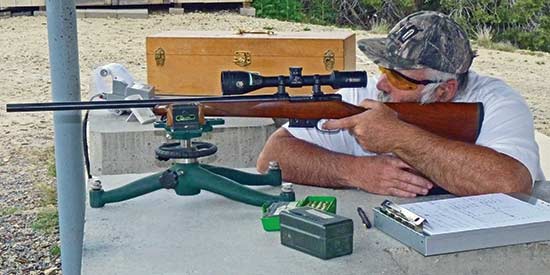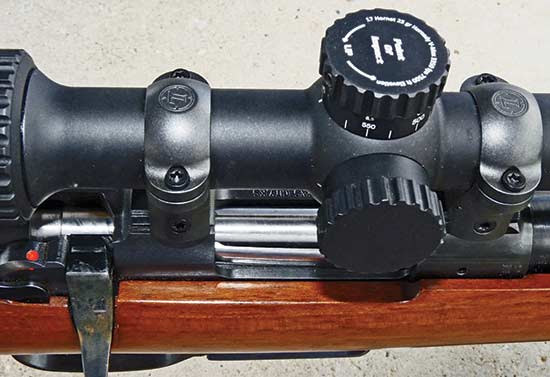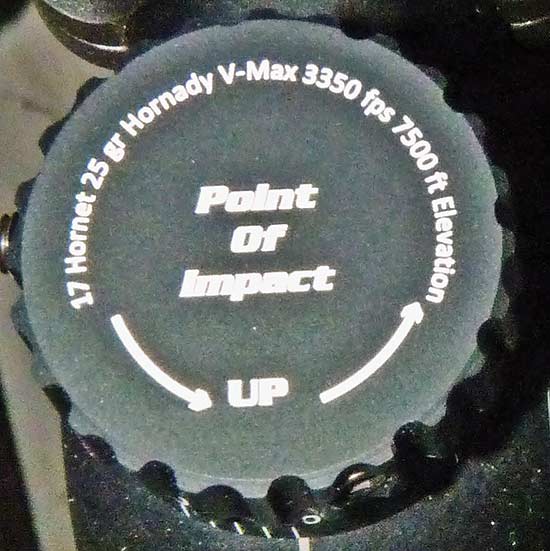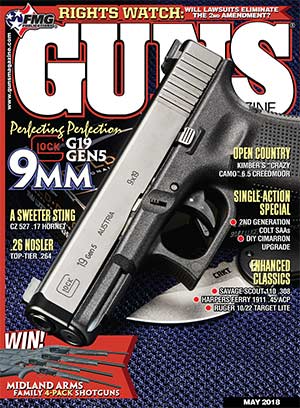A Minimalist Varmint Rifle
The .17 Hornet Has Plenty Of Sting For Low-Cost Pest Eradication
The perfect minimalist varminting combination might not actually exist as a factory option but the CZ 527 Varmint Model in .17 Hornet comes very close. While Hornady .17 Hornet ammunition is excellent, handloaders can do better. The best dies simplify, ease and speed handloading. Burris, Leupold and Swarovski offer appropriate scopes in three price and quality ranges. These combinations make excellent minimalist varminting packages.
Accurately described as a mini-Mauser, the CZ 527 is a light, smooth-working, strong, durable, dependable, accurate and handy rifle. The rifle bolt easily disassembles for cleaning.
Super Trigger
The trigger is excellent, as shipped. It includes a conventional let-off, adjustable to about 2 pounds, and a single-set let-off, adjustable to about 1 pound. Any qualified gunsmith can easily improve on those values with a few minutes of polishing on the appropriate trigger-system surfaces.
One feature I do not like is the unsightly single-stack magazine protruding from the bottom of the receiver. Despite this cosmetic issue, the CZ 527 is the best rifle now offered by any mainstream manufacturer in a minimalist chambering. It is just about as good as it can be.
3 Improvements
While the only minimalist varminting option—.17 Hornet—is a fine choice, other excellent chamberings exist. Availability of a longer-barreled version, and versions chambered in .17 Fireball, .22 Hornet and .221 Fireball would please many varminters.
A longer barrel provides a slight ballistic advantage. More importantly, it significantly reduces muzzle blast, which is important in the varminting field. I prefer 28 or 30-inch barrels, and I can live with a 26-inch barrel.
Having shot my 527 Varmint Model off the bags while developing loads, I am sure a wider forearm would make bench-shooting tasks much easier. These minor but important details would change the 527 from an excellent minimalist varminting choice to an ideal minimalist varminting choice.
Appropriate Scopes
Three scopes ideal on the 527 in .17 Hornet are the Leupold 4.5-14X, VX-3 with the Varmint Hunters reticle, the Burris 4.5-14X C4 Plus, and the Swarovski 3.5-18X, Z5 with the BRX reticle. I have enjoyed using all three.
I had Burris make an elevation turret cap for the 4.5-14X C4 Plus calibrated to the load I use at the elevation where I do most of my varminting. Custom engraved, interchangeable elevation turret knobs calibrated to specific loads is ingenious and is exactly what varmint hunters need. Burris calls this the “Cartridge Calibrated Custom Clicker.” It attaches a durable sticker to the objective bell area of the scope body where the user can add wind correction data for the specified load.
I have used this Burris scope hour after hour without any hint of eye fatigue. While the image is not as bright as the one offered by the more expensive Leupold and Swarovski scopes (nothing is free in optics, increasing brightness and clarity increases cost of production), this Burris scope is bright and clear enough for my needs. Field of view is excellent. All adjustments are handy and precise.
Some would argue more than 14X magnification would be useful for longer shots with a varminting scope. Perhaps so, but 14X is enough for a minimalist chambering. At the other end, 4.5X works perfectly for spotting targets in the varmint field. The wide field of view at the low magnification setting eliminates any need for binoculars when you have a bench and bag set up allowing easy scanning across the field of fire.
The reticle markings are useful. There really is not much I would change about this scope. It is very nearly ideal and the price—starting at $600—is appealing.

This Federal 200 primer was fired in a .22 K-Hornet load generating pressure similar to the .17 Hornet.
Note the unusually deep striker indentation. Even this—the softest pistol primer cup available—simply does
not flatten much in loads at these modest pressures. Only the heaviest charge tested with the 25-grain
bullet showed noticeable flattening.
Handloading
For many years, handloaders working with .17-caliber cartridges had one bullet option, Hornady. The good news is these bullets have always been excellent. Nosler now makes fine .17-caliber varminting bullets. While I have not yet found the time to test, several acquaintances report excellent results.
For now, Hornady is the only option for .17 Hornet cases, and the quality is more than sufficient. For ball-type propellant loads, I settled on the Federal 200, Small Pistol Magnum primer. For tubular-type propellants, I use the milder Federal 100. The Remington 6-1/2 works well too. Use of any other primer will result in a significant change in pressure!
Alliant 1200-R works ideally with 25-grain bullets in the .17 Hornet. It lives up to the Alliant billing by giving at least 100 fps higher velocity than any other propellant will give in .17 Hornet loads. In the .17 Hornet, the small charges used do not seem to create much of a fouling problem Alliant 1200-R has a reputation for in other calibers. I have fired hundreds of rounds without cleaning the bore and without any evidence of a noticeable accuracy degradation.
If you want to have the cleanest possible .17 Hornet loads, use H322. It works just fine and leaves almost no propellant fouling. Velocity will not be as high as you can get with 1200-R but it is clean, and you cannot overcharge a case.
With properly moly-plated bullets and a properly cleaned and prepared bore, I have not yet seen any evidence of copper fouling. Factory loads evidently use a propellant with a copper getter because those, too, leave no hint of metallic bore fouling.
Clean Scene
To remove all traces of powder fouling from the bore, I use a tight bore brush and Sharp ShootR Wipe Out. I run the brush back and forth through the barrel 10 to 30 times, depending upon the number of shots fired since the last cleaning. Periodically, I add Wipe Out to the brush when it extends from the muzzle, to assure that the bore is fully saturated. I then run a saturated patch or two through the bore, and let it soak for a while (overnight, if convenient). Then, I run a few more saturated patches through the bore, to remove all remaining fouling.
To complete bore cleaning and prepare the bore for storage or use, I finish by: Running two rubbing-alcohol saturated patches through the bore. Run two carburetor-cleaner saturated patches through the bore. Run a dry patch through the bore. Run a moly-grease saturated patch through the bore several times, and run a dry patch through the bore.
Handloading Tools
For neck sizing, I use a modified RCBS extended Hornet shellholder and the .17 Remington Collet Neck die. You never need to full-length resize these tiny cases when using them in the same rifle.
For bullet seating, I use the RCBS Gold Medal seating die. Simply drop a bullet into the handy die window, located above the press, and it is ready to seat into the next charged case you insert into the shellholder. For Hornet-based .17s and the .17 VHA, I use the Gold Medal Seating die for the .17 Remington and an extended RCBS Hornet shellholder. With this die, I have loaded more than 5,000 rounds of .17 Ackley Hornet and .17 Hornet ammo. I have damaged exactly one case and I still have all my fingers, all the way to the tips!
Excepting vibratory tumbling (for vanity mostly), running cases through the Lee Collet die represents the entirety of my case preparation. I then seat primers, add charges, and seat bullets. So far, I have not had to trim a single case. (I removed several coils from the striker spring in my CZ 527 to ease bolt manipulation and reduce the possibility of the striker driving the case into the chamber hard enough to set the shoulder back; this keeps headspace at a minimum and thereby limits or eliminates case stretching).
All my loads used moly-plated bullets. When using naked bullets, reduce all charges by about ½ grain to get similar pressure and velocity. I refuse to abuse my barrels (heating and corrosion) and myself (cleaning time) by using naked bullets.
While none of the loads tested showed any evidence of excessive pressure, always test lighter charges first and work up to a maximum load using due caution. Pressure of all tested loads using my components, tools, and techniques seemed mild. My handloads seem to generate pressure similar to factory-load pressure.
All loads with V-Max bullets (moly-plated), Hornady cases (once fired and neck sized using Lee Collet die), Federal 200 primers, 1200-R (swirl charged), and Hornady V-Max at 1.75-inch overall length.
Conclusions
Minimalist varminting options just keep getting better. Recently, I passively persuaded another long-time varmint shooter of the value of smaller cartridges, up to the .221 Fireball, as we shot side by side. All I did was use my .17 while he was shooting a .223 Remington. Repeatedly, I kept on shooting and making hits as he had to stop to let his .223 cool. After he tried my .17, he concluded the .223 is simply more gun than he needs for varminting.
Alliant/Federal
(800) 379-1732
https://gunsmagazine.com/company/alliant-powder/
Burris
(970) 356-1670
https://gunsmagazine.com/company/burris-company/
CZ-USA
(800) 955-6615
https://gunsmagazine.com/company/cz-usa/
Hornady
(308) 382-1390
https://gunsmagazine.com/company/hornady-manufacturing-company/








